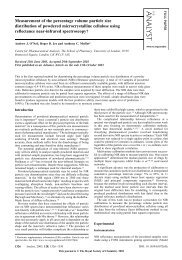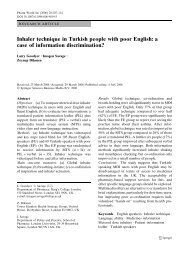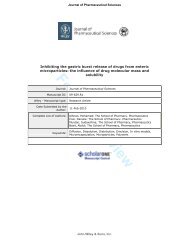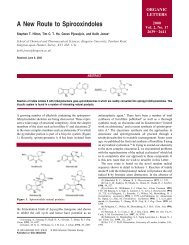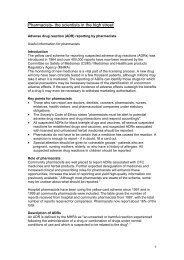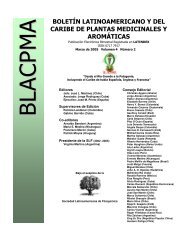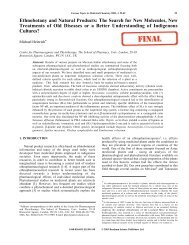SynArfGEF is a guanine nucleotide exchange ... - Pharmacy Eprints
SynArfGEF is a guanine nucleotide exchange ... - Pharmacy Eprints
SynArfGEF is a guanine nucleotide exchange ... - Pharmacy Eprints
Create successful ePaper yourself
Turn your PDF publications into a flip-book with our unique Google optimized e-Paper software.
Introduction<br />
Chemical synapses are specialized sites of the communication between neurons where<br />
information <strong>is</strong> processed and integrated. Electron microscopy has allowed morphological<br />
classification of synapses into asymmetric and symmetric types (Gray 1959). Asymmetric<br />
synapses, also called Gray’s type I synapses, are usually excitatory, use glutamate as a<br />
neurotransmitter and are formed on dendritic spines. They feature a prominent electron-dense<br />
thickening at the cytoplasmic surface of the postsynaptic membrane called a postsynaptic density<br />
(PSD). Intensive proteomic and molecular cloning analyses have identified the molecular<br />
components of excitatory PSDs, which cons<strong>is</strong>t of glutamate receptors, cell adhesion molecules,<br />
scaffolding and adaptor proteins, cytoskeletal proteins, and signaling molecules including<br />
regulators of small GTPases, protein kinases and phosphatases (Scannevin & Huganir 2000).<br />
By contrast, symmetric synapses, also called Gray’s type II synapses, are usually inhibitory, use<br />
either γ-aminobutyric acid (GABA) or glycine as neurotransmitters and are mainly formed on<br />
dendritic shafts and cell bodies. The PSD at inhibitory synapses <strong>is</strong> less electron-dense, having a<br />
similar size to the active zone on the presynaptic membrane. Our understanding of the molecular<br />
organization of inhibitory synapses lags behind that of excitatory PSDs, in part because of the<br />
difficulty of purification of inhibitory PSDs. Several components such as gephyrin and dystrophin-<br />
associated glycoprotein complex (DGC) are found to localize selectively at postsynaptic<br />
specializations of inhibitory synapses and are proposed to be essential for the formation and<br />
maintenance of inhibitory synapses. Gephyrin <strong>is</strong> a 93-kDa peripheral membrane protein that was<br />
originally co-purified with glycine receptors (Pfeiffer et al. 1982). Several lines of evidence indicate<br />
that gephyrin <strong>is</strong> essential for the postsynaptic clustering of glycine receptors (Feng et al. 1998,<br />
Kirsch et al. 1993) and α2- and γ2-subunit containing GABAA receptors (GABAARs) (Essrich et al.<br />
1998). Gephyrin functions as synaptic scaffold and regulator of receptor trafficking by interacting<br />
with various membrane, signaling, cytoskeletal, and trafficking proteins (Kneussel & Betz 2000,<br />
Fritschy et al. 2008). Among gephyrin-interacting proteins, collyb<strong>is</strong>tin, a <strong>guanine</strong> <strong>nucleotide</strong><br />
<strong>exchange</strong> factor (GEF), was originally considered to govern synaptic gephyrin localization, since<br />
collyb<strong>is</strong>tin splice variants lacking a src homology (SH) 3 domain can recruit gephyrin from<br />
intracellular aggregates to submembrane clusters in heterologous transfection systems (Harvey et<br />
al. 2004, Kins et al. 2000). However, most <strong>is</strong>oforms in vivo harbor an SH3 domain, which mediates<br />
activation of collyb<strong>is</strong>tin-mediated gephyrin clustering by neuroligin 2 (Poulopoulos et al. 2009).<br />
Curiously, studies with collyb<strong>is</strong>tin-deficient mice have revealed that collyb<strong>is</strong>tin <strong>is</strong> only essential for<br />
gephyrin-dependent clustering of specific subsets of GABAARs in the hippocampus and amygdala<br />
(Papadopoulos et al. 2007), suggesting that other clustering mechan<strong>is</strong>ms must operate at<br />
inhibitory synapses. On the other hand, the DGC <strong>is</strong> a large multiprotein complex that links the<br />
extracellular matrix to the cytoskeleton. Several components of the DGC, including α- and β-<br />
dystroglycan, dystrophin, and β-dystrobrevin were shown to selectively localize to inhibitory<br />
synapses on neuronal somata and dendrites (Levi et al. 2002, Knuesel et al. 1999, Brunig et al.<br />
2002, Grady et al. 2006). A study with dystrophin mutant mdx mice also demonstrated that a lack



